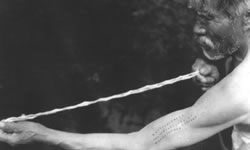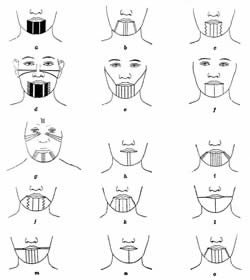Marks of Transformation:
Tribal Tattooing in California and the American Southwest
Article © 2010 Lars Krutak
Identification & “Money” Marks
The Mattole also employed a kind of penal tattooing, which may have been characteristic of other tribes in the region based on similar descriptions of the markings. Speaking about men’s tattoos, the Mattole elder Isaac Duncan stated about 1928: “They did not tattoo the forehead except when they put a single round dot on the forehead between and just above the eyebrows. They did this when a man had committed a crime and a person so marked did not live in the village. He hung around the outside and could not buy himself a wife.
Many northern Californian and Oregon tribes also placed tattoos on their arms to measure strands of dentalia shell that was utilized as a local form of currency. Karok men tattooed their arms with “cross bars” to measure dentalia. But these markings also indicated their wealth in the shell money, each bar representing not only a string of the precious material but also its exact length. Bars on the inner side of the forearm displayed the number and lengths of strings of five measured from the hand; those on the inner side of the upper arm, strings of ten. |
 |
Tolowa. Man with tattoo marks used to
measure dentalia, ca. 1900. |
|
|
The Hupa called the shell money by several names depending on the tribe they were trading with, and the unit they were measuring. Individual shells were measured and their value determined by the creases on the left hand. The longest known shells were about 2 1/2 inches long. In measuring, a trader would reach from the crease of the last joint of the little finger to the crease on the palm opposite the knuckle joint of the same finger. The value of such a piece in early days was about $5.00. Shells of this length were called diñket. The next smaller shells were called kiketûkûtxoi, and measured about 2 3/8 inches. These were worth about $1.50 each. A shell which was 1 7/8 inches long was called tewōlahit and was valued at $1.00. The smallest shells were about 1 1/8 inches long and were called xōstanhit. Their value was from twenty-five cents to fifty cents. Shells smaller than these were not rated as money and had no “decoration.” Shells of value were wrapped spirally with fish-skin or snake-skin and usually a tuft of red feathers, probably from the woodpecker's crest, adorned them. |
Stringed shells reached from the thumb nail to the point of the shoulder. Eleven of the largest size filled such a string and were called mōanaLa. Twelve shells of the next smaller size composed a string and were mōananax. Thirteen shells were called mōanatak, and fourteen of the smallest shells mōanadiñk, which was the largest number placed on a string. These strings were approximately twenty-five inches long.
| Since all hands and arms were not of the same length it was necessary for the man, when he reached maturity, to establish the values of the creases on his hand by comparison with money of known length as measured by someone else. For this reason, he had a set of lines tattooed on the inside of the left forearm. These lines indicated the length of five shells of the several standards. The measures were subdivided, there being lines for mōanaLa long and mōanaLa short, and so on. This was the principal method of estimating the money. The first five on the string were measured by holding the tip of the first shell at the thumb nail and drawing the string along the arm and noting the tattooed mark reached by the butt of the fifth shell. In like manner the last and intermediate sets of five were measured. |
 |
California Women’s facial tattooing, ca. 1920. A) Yurok; B-C) Costanoan; D) Sinkyone; E-F) Maidu; G) Yuki; H-O) Chukchansi and Yokut. |
Next Page |
1
|
2 |
3 |
4 |
5 |
6 |
7 |
Museum photo gallery of the images
on this page may be seen here. |


